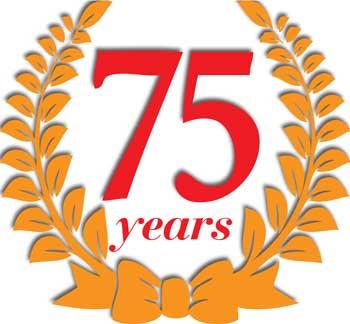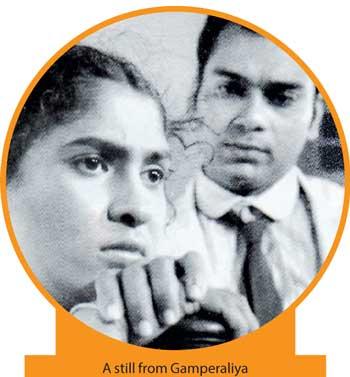Reply To:
Name - Reply Comment
 Published on May 1, 1944, Gamperaliyacelebrates its 75th anniversary this year. The fact that no one announced this on TV or radio, authored at least one critical piece (in English) on the significance of the work, or even organised a school or university level discussion of it, speaks volumes about our priorities. There was one, organised two weeks ago at the Film Corporation. If not many attended, it should come to no surprise; people rarely have time for such affairs these days.
Published on May 1, 1944, Gamperaliyacelebrates its 75th anniversary this year. The fact that no one announced this on TV or radio, authored at least one critical piece (in English) on the significance of the work, or even organised a school or university level discussion of it, speaks volumes about our priorities. There was one, organised two weeks ago at the Film Corporation. If not many attended, it should come to no surprise; people rarely have time for such affairs these days.
What is significant about Gamperaliyais its dualistic structure: it was both a product of its time and of a time preceding it; it was a novel in the conventional mould, yet it also broke through that mould. Richard Simon’s complaint that “it plods” and that “in far too much detail” it was filled “with things unsaid” reveals the inadequacies of assessing the novel from the standpoint of the Western novel. This is not to say it did not lack the kind of finesse which later Sinhala novels would contain. However, to judge Gamperaliya, it is necessary to assess why it was so groundbreaking.
 The Sinhala novel, if such a thing existed or flourished at the time, was primarily a didactic genre: it was used to propagate nationalist sentiments. The two great figures here were Piyadasa Sirisena and W.A. de Silva. They pandered to an audience that was primarily a petty bourgeoisie composed of a Sinhala and Buddhist street merchant class. Sirisena, of course, used his novels as a rallying point against Westernization, while de Silva borrowed freely from Rider Haggard and Walter Scott. Despite these differences, they targeted the same crowd, which is why the shift from the one to the other, as Tissa Abeysekara wrote, “was merely a matter of age” while the shift from them to Wickramasinghe entailed “a matter of taste and literary sensibility.”
The Sinhala novel, if such a thing existed or flourished at the time, was primarily a didactic genre: it was used to propagate nationalist sentiments. The two great figures here were Piyadasa Sirisena and W.A. de Silva. They pandered to an audience that was primarily a petty bourgeoisie composed of a Sinhala and Buddhist street merchant class. Sirisena, of course, used his novels as a rallying point against Westernization, while de Silva borrowed freely from Rider Haggard and Walter Scott. Despite these differences, they targeted the same crowd, which is why the shift from the one to the other, as Tissa Abeysekara wrote, “was merely a matter of age” while the shift from them to Wickramasinghe entailed “a matter of taste and literary sensibility.”
By the time of Gamperaliya’s publication, the author had written seven novels, six critical essay collections, two or three short story collections, and one play. In spite of his hostility towards Wickramasinghe’s anti-Sanskrit bias, Ediriweera Sarachchandra saw in the novel something more than a masterpiece: he was convinced it represented a departure from the route taken by Sirisena and de Silva (Almost 20 years later, after watching Lester James Peries’ film, he made the same comment when he described it as an opa pathika or immaculately conceived, work of art.)
However, its status as a groundbreaking work of art could not have owed to its form only, though by the standards of its time it certainly did stand out; what would have moved Sarachchandra to proclaim it as a landmark would have been its theme: for the first time, a Sinhala novel centring on ordinary characters had been written.
In this, Wickramasinghe consciously followed the modernists of the 20th century – Joyce, Woolf, Eliot, Proust – by sketching out, as his protagonists, characters from an intermediate class: not the peasantry, but the traditional elite. Gamperaliya depicts a class that has fallen from grace: the emancipation of the capitalist bourgeoisie and the loosening up of caste-based hierarchies threaten to bring down this class. There is no attempt at romanticising its milieu, which I think was Wickramasinghe’s achievement; indeed, he frequently implies that their order must pass to another.
 The prejudices of the aristocracy (Nanda’s family), the upstart arrogance of the new bourgeoisie (Piyal’s family), and the adherence to the caste-based taboos by the former (even when Piyal offers to restore their mansion, Nanda’s mother and sister, the latter more than the former, refuse) paint a picture of Sinhalese village life the deterioration of which Wickramasinghe may have seen in Colombo.
The prejudices of the aristocracy (Nanda’s family), the upstart arrogance of the new bourgeoisie (Piyal’s family), and the adherence to the caste-based taboos by the former (even when Piyal offers to restore their mansion, Nanda’s mother and sister, the latter more than the former, refuse) paint a picture of Sinhalese village life the deterioration of which Wickramasinghe may have seen in Colombo.
The difference between the old and new elite crop up in the subtlest of ways, which roundly refutes Richard Simon’s charge that the novel plods: when, for instance, news of Jinadasa’s death reaches Nanda’s mother and Piyal’s mother, the former blurts out, “Eyage karumeta api monawa karannada?” – “What could we have been done to help him avoid his fate?” The latter on the other hand, reflecting the distaste with which the new elite regard feudal beliefs, remarks, “Karumeta nemeyi; mama kiyanne kalakanni kama kiyala” – “It wasn’t his fate: it was his wastefulness.”
The story in the novel takes place broadly on three levels: the crumbling down of the Kaisaruwatte family, the growing feelings of Nanda towards Piyal after he returns to his village and the sojourns in Colomboof Tissa. The film adaptation, the finest that could have been made, omits the third of these, a pity given that the actor portraying Tissa, Wickrema Bogoda, was the perfect moody, introspective actor for the role; in Kaliyugaya Bogoda proved this, thanks to a more enlarged performance.
The reason why I believe it was essential to the plot was that, in Tissa’s character, we come across Wickramasinghe’s own personality. In his sexual encounters, his feelings towards women, his inability to get close to them, and his kalakannilifestyle, we see the finest character portrait Wickramasinghe came up with: he is, in both Gamperaliyaand Yuganthaya, a definitive precursor to Aravinda from Viragaya, in turn published a year before Kaliyugaya. Tissa’s encounter with Magilin the prostitute in Colombo, the sensation triggered by his visit to the shanty settlement she lives in, and the stench of the gutters fusing with the smell of a chicken being fried, bring to mind the Madeleine cake from Proust’s “In Search of Lost Time”; this sequence, related almost as an interior monologue, is remembered beautifully by Tissa in Kaliyugaya.
The novel begins “two three days before the Sinhala New Year of 1904” which was not a coincidence: coming in four years before a rubber boom which would change the economic landscape of the country, high population growth rates in the South had by that time compelled people, particularly those within the lower end of the hierarchy in their villages, to seek their fortunes elsewhere, especially in Colombo.
 While they escaped and made those fortunes, however, they could not divorce themselves from the links they had with their communities – which explains Piyal’s return to his village, and, rather poignantly, Nanda’s inability to pick up English. The Kaisaruwattes in that sense have been described as inert. This characterisation of them is by no means erroneous: they are indeed slow to react to the changes around them. Unlike the heroes of Lampedusa’s The Leopard, the world doesn’t rebel against them: on the contrary, they are the ones rebelling, futilely, against that world.
While they escaped and made those fortunes, however, they could not divorce themselves from the links they had with their communities – which explains Piyal’s return to his village, and, rather poignantly, Nanda’s inability to pick up English. The Kaisaruwattes in that sense have been described as inert. This characterisation of them is by no means erroneous: they are indeed slow to react to the changes around them. Unlike the heroes of Lampedusa’s The Leopard, the world doesn’t rebel against them: on the contrary, they are the ones rebelling, futilely, against that world.
With the motif of the rags-to-riches rise of Piyal as well as his conquest of the woman he had once tried and failed to marry, Wickramasinghe returned to tropes from a more classical, romantic literary era. The regaining of a lost love; the sudden, coincidental encounters after a long period of separation; the confusion over the identity of a dead man; and the deployment of private detectives to seek that dead man, are plot devices which could have come from a Victorian era mystery romance. What explained their presence in a novel which had detoured from the path of such romances?
The reason, Tissa Abeysekara argued, was that though Wickramasinghe wanted to unleash a revolution in the literary sphere, he did not do so by abandoning plot devices that he himself had resorted to before: that is why, as I wrote before, Gamperaliyais both a product of its time, and of a time that preceded it. There is no doubt he targeted an audience beyond the popular reader; on the other hand, he couldn’t alienate this reader either. Perhaps, that may be why subsequent readings of it tended to emphasize on the Piyal-Nanda-Jinadasa triangle, omitting Tissa’s presence in the plot.
In other words, the Piyal-Nanda-Jinadasa triangle was what popular readers would have taken to; hidden beneath it, conversely, were the layers that those popular readers would have missed. It was a world Wickramasinghe had to occupy between the petty bourgeois romances and potboilers from the Victorian era and the modernist stream of consciousness interior monologues from his time. Naturally, he had to compromise there: another decade or so would follow before the peraliyain his country’s political and social fabric could empower him to fully embrace his own distinct style.
By the time of Viragaya, which he presents as a series of minimalistic vignettes, he has bridged the gap from the one to the other; at the time of Gamperaliya, he was just learning to bridge it. The significance of the novel therefore comes from the tension between these two styles; in 1944, his reading public was yet to clearly discriminate between them. It would take another two or three novels by the man for them to learn how to do that. By then, the Sinhala novel had entered a new phase, never to go back to its classical, tradition bound past again. That to me is the enduring legacy of this, the single greatest contemporary Sinhala novel ever written.